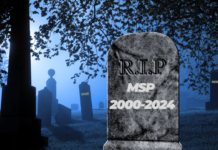All the new printers have built-in self-healing security features with protection down to the BIOS, secure whitelisting, and run-time intrusion detection. All these are backward compatible to the LaserJets announced in the spring, and all but the BIOS protection is compatible on HP printers made since 2010.
Last March HP introduced the first models of its latest LaserJets, emphasizing their engineering advancements, that they were much smaller, faster, and more convenient than past LaserJets. Today, they are announcing three more LaserJets, two of which are MFPs and all of which are for the enterprise. While they build on the same engineering advancements as the spring models, HP is really stressing the new security innovations in these machines, which go well beyond what was in the earlier ones.
“Our messaging is that we are defending your network with the world’s most secure printers,” said Brian Schmitz, Director, Future Product Marketing, LaserJet and Enterprise Solutions. “We are introducing a very deep level of embedded device protection.”
Schmitz said that this is part of a broader HP Client Security Strategy, to provide the deepest security across PCs and printers. Three security elements are being featured: a self-healing BIOS, secure whitelisting, and run-time intrusion detection.
“The approach to security across PCs and printers should be similar,” he said. To facilitate this, these LaserJet Enterprise printers are the first to leverage HP Sure Start, a self-healing BIOS that was introduced on HP’s Elite line of PCs in 2013.
“HP Sure Start technology makes sure that the BIOS has not been tampered with, and if it has been, it can heal itself,” Schmitz said. “It will be on printers for the first time this fall.
“The BIOS is an attack target for rootkits,” said Shivaun Albright, Distinguished Technologist at HP. “When the BIOS loads, a check makes sure it hasn’t been tampered with. If it has, then it can be automatically restored to the Golden Copy, which Sure Start protects with hardware.”
The HP Secure Whitelisting ensures that only known, good firmware can be loaded and executed on a printer, by validating the digital signature of code as it is loaded into memory.
“The Whitelisting feature makes sure the code came from HP and it’s authentic,” Albright said. “It can ensure we load only known good code – only known firmware we have signed that has not been tampered with.”
The Run-time Intrusion Detection is a powerful new feature which provides in-device memory monitoring for malicious attacks and can be integrated with security information tools like HP ArcSight. It was developed in partnership with embedded device security specialist company Red Balloon Security.
“It does in-memory mirroring of the device looking for anomalous behavior issues,” Albright said.
All this is managed by the HP JetAdvantage Security Manager, HP’s policy-based print security compliance tool. It was recently updated for greater automation, including auto-discovery of devices, to make it easier to find and add printers to manage.
All these new features will be standard on new HP LaserJet Enterprise printers and OfficeJet Enterprise X printers with HP PageWide Technology going forward, and are also backward compatible on the new HP LaserJet Enterprise printers available since the spring through HP FutureSmart service pack updates. The microcontroller for Sure Start is already on these devices and requires only a firmware update.
In addition, Whitelisting and Run-time Intrusion Detection can be added to many existing HP LaserJet Enterprise printers and OfficeJet Enterprise X released since 2010 – but not the Sure Start capability.
“The Sure Start technology won’t be available on the older devices because there is a hardware dependency we don’t have on them,” Schmitz said.
All three new models are replacements for existing products. The HP LaserJet Enterprise M506 printer replaces the P 3015. The other two offerings are MFPs. The HP LaserJet Enterprise MFP M527 replaces the M525, while the HP Color LaserJet Enterprise MFP M577 replaces the M575. A fourth printer, the HP LaserJet Enterprise M553, which replaces the M551, is due in the spring.

The HP Color LaserJet Enterprise MFP M577
The feed and speed increases on all the new machines are impressive. Duplex printing is 29 to 71 per cent faster, depending on the model. First page out speed is enhanced from 21 to 46 per cent. Printing is also between 49 and 61 per cent faster from sleep.
“You typically don’t see improvement like this as dramatic in laser printing,” Schmitz said. “Usually 4-10 per cent is good. Up to 70 per cent comes only comes with fundamental technical change.”
Schmitz also called attention to what he described as additional thoughtful touches, like a faster setup where you plug the printer in, and it will print, a pull-out keyboard, a Cavelight illuminated output tray, and a stapler built into the printer. These machines are also smaller than the previous generations, from between 17 and 24 per cent.
The HP LaserJet Enterprise M506 series will be generally available on October 1, priced between $USD 649 and $USD 949. The HP LaserJet Enterprise MFP M527 and HP Color LaserJet Enterprise MFP M577 series printers will both be generally available on November 2. The M527 is priced between $USD 17-99 and $USD 2599. The M577 lists between $USD 2,199 and $USD 3,099.
Source: ChannelBuzz












